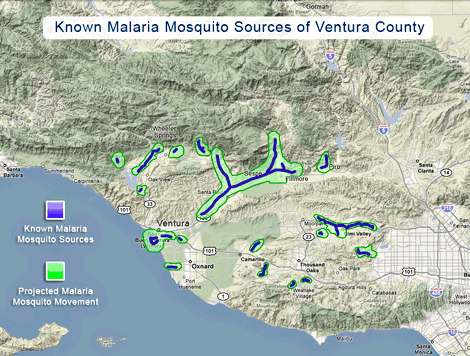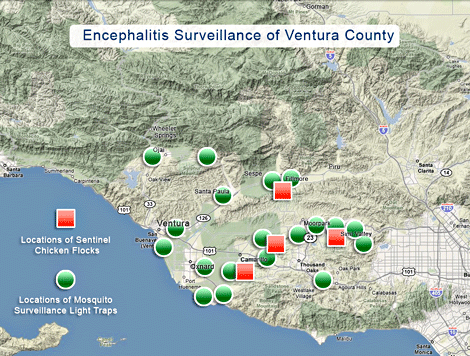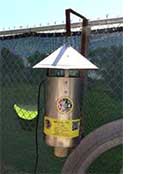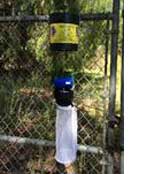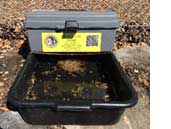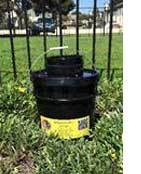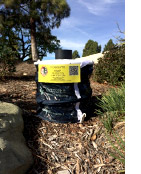Mosquito Transmitted Disease Surveillance Program
Background
Mosquito-borne diseases that are of concern in Ventura County are St. Louis Encephalitis (SLE), Western Equine Encephalitis (WEE), West Nile Virus (WNV), and Malaria. Encephalitis is a viral disease that affects the central nervous system and causes an inflammation of the brain.
The different encephalitis strains are caused by different viruses but are all transmitted by the bite of a mosquito. Malaria is caused by the organism Plasmodia, and is characterized by periodic attacks of chills and fever, and can persist in individuals without treatment. Malaria is also transmitted by the bite of a mosquito.
The Ventura County Arbovirus Surveillance Program was initiated in 1985 after an unprecedented 27 cases of SLE occurred in four Southern California counties during 1984. An extensive survey performed in Ventura County showed that all encephalitis vector mosquitoes, especially Culex tarsalis, were found countywide, but no evidence of SLE or WEE was documented at that time.
Information from this survey also provided locations and population densities of Anopheles mosquitoes, which are the vector for malaria. Click here for a list of the mosquito species found in Ventura County, their population density, and the diseases which can be transmitted by each species.
See a map below for locations of the Malaria Mosquito (Anopheles).
Based on this information, the Board of Supervisors established an Arboviral Surveillance and Countywide mosquito abatement program, which has continued to the present time. Also, see the Mosquito Control Program webpage for more information.
Encephalitis Surveillance
The primary objective of the Arboviral Surveillance Program is to prevent the transmission of encephalitis virus to humans. The surveillance program in Ventura County is multifaceted and includes:
- Mosquito population and species monitoring through the placement of 20 mosquito light traps in representative areas of the County.
- Adult mosquito monitoring and testing for SLE, WNV, and WEE virus.
- Serological monitoring of sentinel chicken flocks in four representative areas of the County.
- Participation in the California Department of Health Service’s wild bird surveillance program.
Dead birds are collected and submitted for testing for WNV. To report a dead bird, call toll free: 1-877-WNV-BIRD.
To report a dead bird using an online form, click here.
See a map above of mosquito light trap and chicken flock locations.
Types of Traps
New Jersey Light Trap
The New Jersey light trap is generally used to measure the effectiveness of mosquito control in populated areas and provides historical data of mosquito species and counts. Mosquitoes collected from these traps cannot be tested for arbovirus. This trap is usually permanently mounted and depends upon a 110-volt source of electric power that supplies an attractant light and fan. Mosquitoes attracted to the light are funneled into a collection jar. Ventura County has 20 of these traps around the county. Traps are left out permanently, and samples are collected every seven days.
CDC / EVS type CO2 –Baited Trap
The CDC (Center for Disease Control) / EVS (Encephalitis Virus Survey) trap uses carbon dioxide as the primary attractant. The CDC trap is used to collect live mosquito samples. These samples can be used for mosquito species determination mosquito counts and can be tested for arboviruses. These traps are set out for one night at a time at different locations in a specific area that is to be surveyed. Ventura County has 6 CDC traps used for this purpose.
Gravid Trap
The Gravid trap attracts females by means of an oviposition medium contained in a pan below the trap. The trap operates by creating an upward current of air from within the confines of the pan so that the mosquitoes are blown into the collection bag during their preoviposition examination of the oviposition medium. Ventura County has 2 of the gravid traps, and these are set out for one night at a time. These traps collect females of container breeding species that are looking for an oviposition site and are used for species determination mosquito counts and can be tested for arboviruses.
CDC-AGO (Autocidal Gravid Ovitrap)
The AGO trap collects females that are looking for an oviposition site. These traps are used to monitor for invasive Aedes mosquitoes. This device is 45 centimeters tall with a 10-liter capacity to hold an attractant, such as water and decaying vegetation. The mosquitoes are captured by a nontoxic adhesive. Ventura County puts out up to 15 traps in areas to be sampled. The traps are left out for several days at a time.
BGS Mosquito Trap
The BG-Sentinel trap is also used to monitor for invasive Aedes mosquitoes. The traps use a combination of non-toxic substances that are also found on human skin to lure mosquitoes into convection currents and, which draw them into the collection bag.
All traps are prominently labeled for the public and emergency responders, as shown below.
In 1992, 2 chickens from the Hill Canyon, Thousand Oaks sentinel flock tested positive for SLE. At this same time, the only known confirmed human case of SLE in Ventura County was diagnosed in a woman who lived in Oxnard. As of October 2018, 9 adult mosquito collections, 332 wild birds, 24 sentinel chickens, and one squirrel have tested positive for WNV. There have also been 32 human and 15 equine cases. For more information on WNV, click here.
The following actions will be taken in response to a positive finding of encephalitis virus:
- Notify the County Health Officer
- Notify all local and State agencies that could be involved in any follow up effort.
- Notify the media via a press release.
- Check mosquito light trap data from the area to determine population density, and species of mosquitoes.
- Set out live traps for mosquitoes.
- Survey all mosquito breeding sources in the area.
- Investigate area for unknown sources of mosquito breeding.
Depending on these findings, send adult mosquitoes collected in the area to the State for virus testing.
Mosquito Species Of Ventura County
| Mosquito Species | Population Density* | Significance |
|---|---|---|
| Culex (Cx) tarsalis | High | SLE/WEE |
| Cx quinquefasciatus | High | SLE/WEE/WNV |
| Cx erythrothorax | Medium | Nuisance |
| Cx stigmatosoma | Medium | Nuisance |
| Cx boharti | Rare | Nuisance |
| Cx restauns | Rare | Nuisance |
| Cx thriambus | Rare | Nuisance |
| Culiseta (cu) incidens | Medium | Nuisance |
| Cu inornata | High | Nuisance |
| Cu particeps | Rare | Nuisance |
| Anopheles (An) franciscanus | Medium | Nuisance |
| An freeborni | Medium | Malaria |
| An occidentalis | Rare | Nuisance |
| Aedes (Ae) dorsalis | Rare | Nuisance |
| Ae aegypti | Medium | Nuisance |
| Ae increpitus | Rare | Nuisance |
| Ae sierrensis | Medium | Dog heart worm |
| Ae squamiger | Rare | Nuisance |
| Ae taeniorhynchus | Medium | Nuisance |
* Definitions:
High – This species is found throughout Ventura County, sometimes in high numbers.
Medium – This species is only found in specific areas.
Rare – This species is seldom found in Ventura County.

